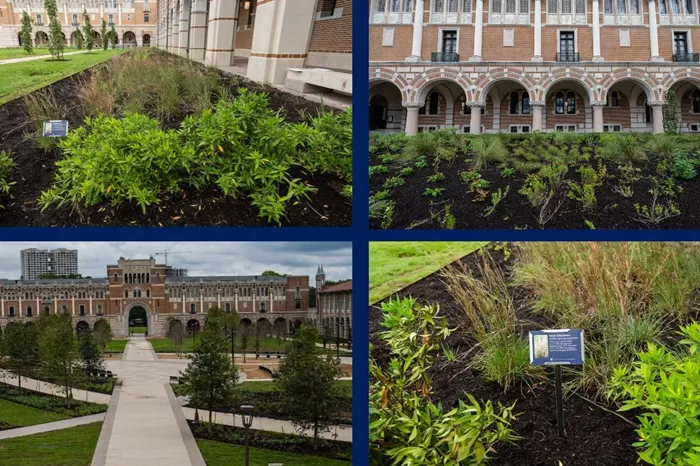Rice University Unveils Redesigned Academic Quadrangle with New Biodiversity Boost.
Rice University recently introduced a significant transformation to its iconic Academic Quadrangle, revealing a refreshed landscape teeming with life. The redesign includes 42 species of plants, enriching the area’s biodiversity and enhancing the overall beauty of the beloved campus hub.
The project has turned what was once a four-acre patch of grass, often exposed to the harsh sun, into a lush, shaded oasis. The new landscape features blooming flowers, vibrant trees, and inviting seating areas. The internationally renowned landscape architecture firm Nelson Byrd Woltz (NBW) collaborated with Rice to bring this vision to life after years of planning.
A Vision for Community Engagement
Thomas Woltz, the senior principal at NBW, emphasized the importance of creating spaces that foster community. “I believe that the land holds our human story,” Woltz said. “This project addresses the students’ and faculty’s desire to reimagine the space. We have designed areas that welcome student life and encourage interaction between the community, faculty, and alumni.”
Incorporating feedback from Rice University’s faculty, students, and staff was key to shaping the quad’s new look. George Ristow, university architect and assistant vice president for campus planning and design, highlighted NBW’s ability to align their designs with the university’s needs. “Rice selected NBW for their remarkable work, including local projects like Memorial Park and the Rothko Chapel,” said Ristow. He added that the firm’s commitment to gathering input from the Rice community ensured the project reflected shared values.
New Life in the Heart of Campus
The redesigned Academic Quad is now a vibrant mix of native plants and welcoming spaces. Upon entering through the Sallyport, visitors are greeted by lines of bald cypress trees, which frame the area between Sewall, Lovett, and Herzstein Halls.
The quad now features native Texas plants, carefully chosen for their ability to support pollinators and increase biodiversity. “We’ve transformed the area into a garden of flowering plants, most of which are native to Texas,” Woltz said, adding that the new plants invite pollinators such as butterflies, bees, and other insects into the space.
Moving through the quad, the landscape includes deciduous trees that offer shade and long, curved benches that encourage community interaction. On the opposite end, loblolly pines create a serene space that Woltz described as an “outdoor living room.”
Native Plants for Sustainability
A key aspect of the redesign was focusing on native plants, which are well-adapted to the Texas heat and help with local drainage. Cassidy Johnson, assistant teaching professor of biosciences, emphasized the importance of using native species in landscaping. “Native plants fully support the local wildlife. They coevolved with pollinators, which are essential for agriculture,” Johnson said.
Native plants are not only eco-friendly but also efficient in water usage. Their root systems help absorb and retain more water, improving the area’s drainage.
A Greener Future for Rice’s Campus
More than 24,000 new plants now thrive in the quad, including a variety of shade trees, perennials, and shrubs. Over 90 new trees have been planted, with two large, mature oaks preserved to maintain the area’s ecological balance. A new pathway, lined with Monterrey oaks, creates a shaded walkway through the quad, promising to provide continuous cover as the trees mature.
The newly redesigned quad also enhances the Lynn R. Lowrey Arboretum, a key teaching and research resource on campus. Spanning the entire university, the arboretum includes a wide collection of native and introduced plant species that thrive in Houston’s wet prairie climate.
Established in 1999 to honor distinguished horticulturist Lynn R. Lowrey, the arboretum includes plants Lowrey himself introduced to Texas, such as the Monterrey Oak and Mexican Scullcap. This latest redesign integrates the arboretum’s collection with the heart of Rice’s campus.
A Campus United by Nature
“The entire campus is an arboretum, which is unique compared to our peer institutions,” said Johnson. She believes the new quad connects the university’s diverse plant life, bringing the arboretum into the core of student life. “This revision helps tie all the elements together,” she said. “People already recognize Rice’s canopy, but now this redesign brings that connection to the forefront, right in the heart of the campus.”
With its lush greenery and thoughtful design, the revamped Academic Quadrangle not only enhances the beauty of Rice’s campus but also serves as a model for sustainability, biodiversity, and community engagement.


